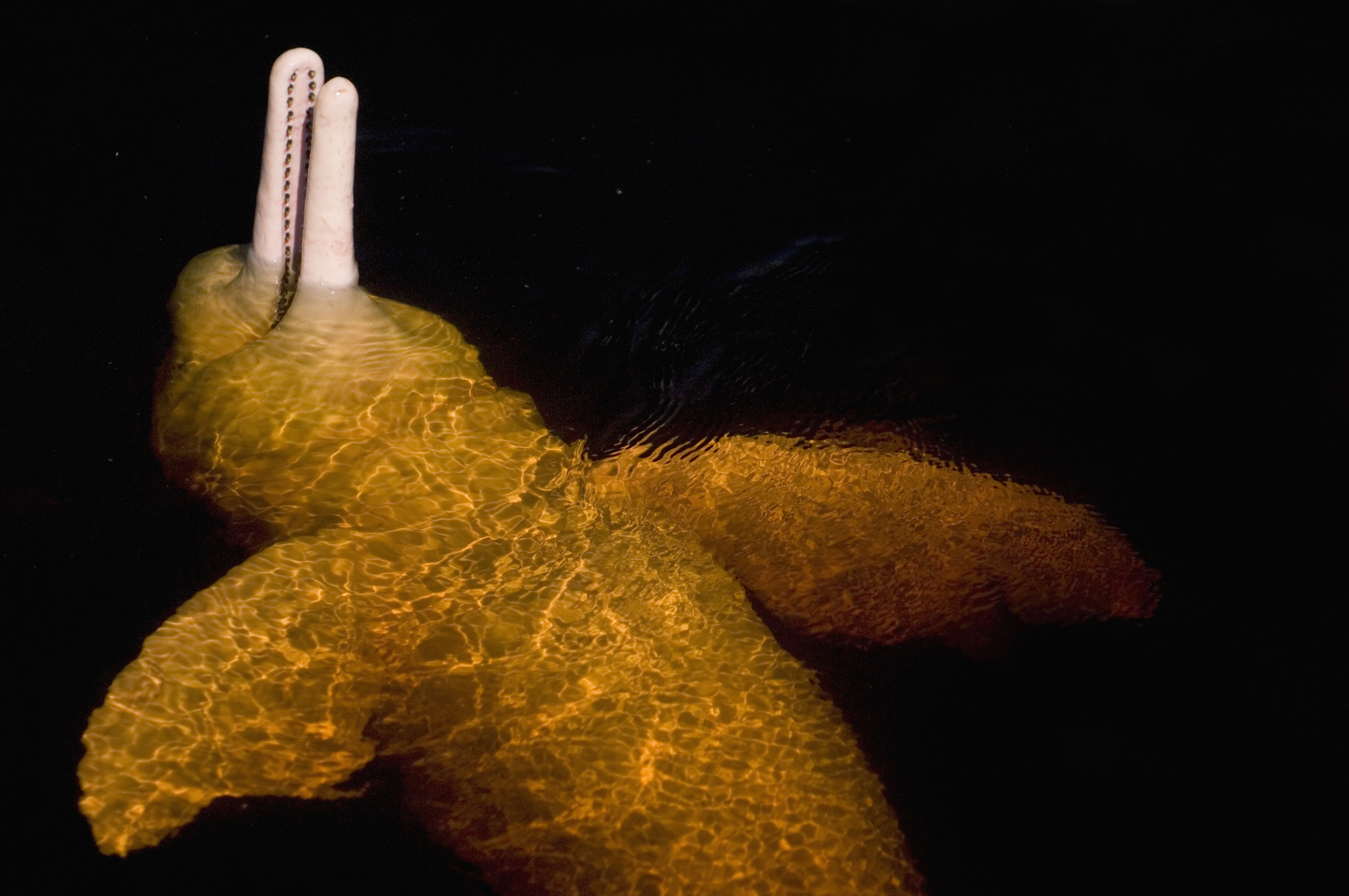One of the most majestic water shows in the world cannot be found in front of the grand casinos of Las Vegas or Macao. Instead it can be seen, sporadically, in the brown waters of the Amazon and other South American rivers occupied by the river dolphins, also called botos. As the botos grow, their bodies blush a pale pink, a color that is particularly evident in males. When the male dolphins need to defecate, they do so without any fuss: emptying their bowels directly into the river. But when the males pee, they sometimes get a little fancy with it.
In such cases, a male boto will slowly roll onto his back, exposing his belly to the surface. Then, like a hoisted flag, his penis will gradually emerge from its usually sheathed position. And finally, the boto will begin to pee in one mighty stream that reaches as high as three feet in the air. The powerful arc of the boto's pee sails over his own head and eventually plummets into the water several feet beyond the tip of the dolphin's long snout, or rostrum. Once the boto has peed all its pee, he will slowly roll over once again and resume swimming. With a show like this, who wouldn't want a front-row seat?
Claryana Araújo-Wang, who researches the botos with Canada's CetAsia Research Group, recently published a paper with colleagues describing this fascinating behavior in the journal Behavioural Processes. In total, the researchers documented 36 separate incidents in which male botos peed this way.
Araújo-Wang and John Wang, a researcher with the same group, first observed this extreme sort of peeing more than a decade ago while surveying the dolphins in the Tocantins River in Brazil. On two separate occasions, they watched as a male flipped onto his back, exposed his penis to the air, and urinated into the sky. On two other occasions, they saw a male displaying his penis as if about to urinate, but they were too far away to actually see the stream. In a 2012 paper, they published a photo of one of the aerial urinations: an arc of water emerging from a tapered, conical penis extruding from the water like a dorsal fin. "We had no idea we were going to observe the animals performing this behavior as we have never heard of it before," Araújo-Wang wrote in an email.
For the new paper, the researchers observed 25 aerial urination events from September 2014 to March 2018. In these observations, only male dolphins peed into the air. And the botos engaged in this urination style indiscriminate of season; wet or dry made no difference. The dolphins could pee in the air for as little as one second and as long as 41 seconds. "We conduct land-based observations and usually spend several hours during the day collecting different types of data on the behavior and ecology of these animals," Araújo-Wang said. The researchers were not, she clarified, "only waiting for this particular behavior of aerial urination."
But perhaps the most surprising discovery was one of community. Researchers found nearly 70 percent of the aerial urination events occurred when the botos were swimming in a group. When a peeing boto was not alone, the waterworks often transformed from a solo show into a pas de deux. In a dozen observations, while one boto was aerially urinating, another male would swim near the urinating dolphin and lift its rostrum toward the first dolphin's pee stream. The researchers refer to this behavioral role as the "receiver." "We were really shocked because it was something that we have never seen before or heard of," Araújo-Wang said.
In three of these observations, multiple other dolphins flocked to a urinating boto. On one day in December 2014, a male bystander boto swam away, to be replaced by another male boto who lifted his rostrum toward the pee stream. Soon after, a calf joined in the whole affair, although it stayed clear of the splash zone.
Although the botos needed to thrust our their penises to successfully pee into the air, the subsequent fate of the penis varied, boto-by-boto. "Sometimes the penis is retracted as he is rolling back or after the pee," Araújo-Wang said. "Also, there are times when the animal doesn’t fully retract the penis after the pee event and we can still observe the penis," she added.
The key question behind this paper—why do this?—remains a mystery. Many terrestrial animals pee selectively to mark their territory, communicate, or select mates. But this behavior has never been observed before in aquatic mammals. The researchers suspect it may be advantageous for a boto to put on such a show. "We hypothesize that aerial urination helps in advertising male quality in terms of social position or physical condition," Araújo-Wang said.
For now, this behavior seems unique to this species, or perhaps even this population. Dolphins are highly intelligent and innovative creatures known to develop and pass on learned behaviors to others in their population. The researchers note that botos have visible bristles on their rostrum, which may help the dolphins sense the chemicals present in another boto's pee. In future studies, analyzing this pee could offer new insight into what, exactly, a boto hopes to learn from his fellow boto's pee. But in the meantime, the secret language of a boto's urine is all his own.







